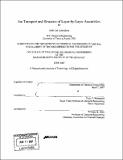| dc.contributor.advisor | Paula T. Hammond. | en_US |
| dc.contributor.author | Lutkenhaus, Jodie Lee | en_US |
| dc.contributor.other | Massachusetts Institute of Technology. Dept. of Chemical Engineering. | en_US |
| dc.date.accessioned | 2007-10-22T17:39:42Z | |
| dc.date.available | 2007-10-22T17:39:42Z | |
| dc.date.issued | 2007 | en_US |
| dc.identifier.uri | http://hdl.handle.net/1721.1/39346 | |
| dc.description | Thesis (Ph. D.)--Massachusetts Institute of Technology, Dept. of Chemical Engineering, 2007. | en_US |
| dc.description | "June 2007." | en_US |
| dc.description | Includes bibliographical references. | en_US |
| dc.description.abstract | Layer-by-layer (LbL) films of various architectures were examined as potential solid state electrolytes for electrochemical systems (e.g. batteries and fuel cells). The relationship between materials properties and ion transport within LbL films was investigated in three systems, described below. The observed structure and properties aid in the design of tunable ultra thin electrolytes. The thermal and mechanical properties of PEO/PAA films were evaluated, aided by a new peel-away technique. Results indicated that the glass transition temperature (Tg) of PEO/PAA films decreases with increasing assembly pH, but when assembled in the presence of salt, the Tg, remains constant. Results indicate that the degree of inter- and intramolecular PAA hydrogen bonding, evidenced by FTIR spectroscopy, controls the observed Tg. The ionic conductivity was found to increase with increasing charge carrier concentration (doping during assembly) and with humidity. Maximum room temperature dry conductivity was -108 S cm-1. Polymer-clay nanocomposites were investigated for structural and transport anisotropy. LPEI/Laponite/PEO films demonstrated an oriented structure where clay nanoplatelets lay parallel to the substrate and assembly in sheets with polymer in-between. | en_US |
| dc.description.abstract | (cont.) In-plane conductivity was 100 (or 7) times higher than cross-plane conductivity in the dry (or 53 % humidity) state. Porous coatings of LPEI and PAA were investigated as potential ultra thin porous supports for non-aqueous liquid electrolyte. The effect of assembly pH and post-assembly treatment ph upon the pore size, porosity, surface roughness and structure was study. Films assembled at ph 5 and treated at pH 2.25 demonstrated the highest porosity (77 %) and two room temperature, dry conductivities of 10-6 and 10-9 S cm-1. The two observed conductivities, or time constants, was attributed to ion transport through liquid-filled pores and the matrix itself. | en_US |
| dc.description.statementofresponsibility | by Jodie Lee Lutkenhaus. | en_US |
| dc.format.extent | 138 leaves | en_US |
| dc.language.iso | eng | en_US |
| dc.publisher | Massachusetts Institute of Technology | en_US |
| dc.rights | M.I.T. theses are protected by copyright. They may be viewed from this source for any purpose, but reproduction or distribution in any format is prohibited without written permission. See provided URL for inquiries about permission. | en_US |
| dc.rights.uri | http://dspace.mit.edu/handle/1721.1/7582 | |
| dc.subject | Chemical Engineering. | en_US |
| dc.title | Ion transport and structure of layer-by-layer assemblies | en_US |
| dc.type | Thesis | en_US |
| dc.description.degree | Ph.D. | en_US |
| dc.contributor.department | Massachusetts Institute of Technology. Department of Chemical Engineering | |
| dc.identifier.oclc | 173611933 | en_US |

